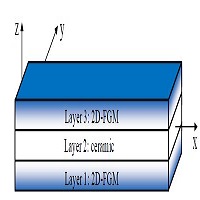Vibration Analysis of Two-Directional Functionally Graded Sandwich Beams Using a Shear Deformable Finite Element Formulation
Keywords:
2D-FGSW beam, refined shear deformation theory, vibration analysis, finite element formulationAbstract
Free and forced vibration analysis of two-directional functionally graded sandwich (2D-FGSW) beams using a shear deformable finite element formulation is presented. The beams considered in this paper consists of three layers, a homogeneous ceramic core, and two functionally graded skin layers. Material properties of the skin layers are supposed to vary in both the thickness and length directions by power gradation laws. Based on a refined shear deformation beam theory, in which the transverse displacement is split into bending and shear parts, a novel finite element formulation is derived and employed in the analysis. Natural frequencies and dynamic response to a harmonic load of the beams with various boundary conditions are computed, and the influence of the material distribution and the layer thickness ratio on the vibration characteristics of the beams is highlighted. Numerical results reveal that the variation of the material properties in the longitudinal direction has a significant influence on the vibration behavior of the beams, and FGSW beams can be designed to achieve desired vibration characteristics by appropriate selection of material grading indexes.

Published
How to Cite
Issue
Section
License
Submission of a manuscript implies: that the work described has not been published before that it is not under consideration for publication elsewhere; that if and when the manuscript is accepted for publication. Authors can retain copyright in their articles with no restrictions. is accepted for publication. Authors can retain copyright of their article with no restrictions.
Since Jan. 01, 2019, AITI will publish new articles with Creative Commons Attribution Non-Commercial License, under The Creative Commons Attribution Non-Commercial 4.0 International (CC BY-NC 4.0) License.
The Creative Commons Attribution Non-Commercial (CC-BY-NC) License permits use, distribution and reproduction in any medium, provided the original work is properly cited and is not used for commercial purposes.



